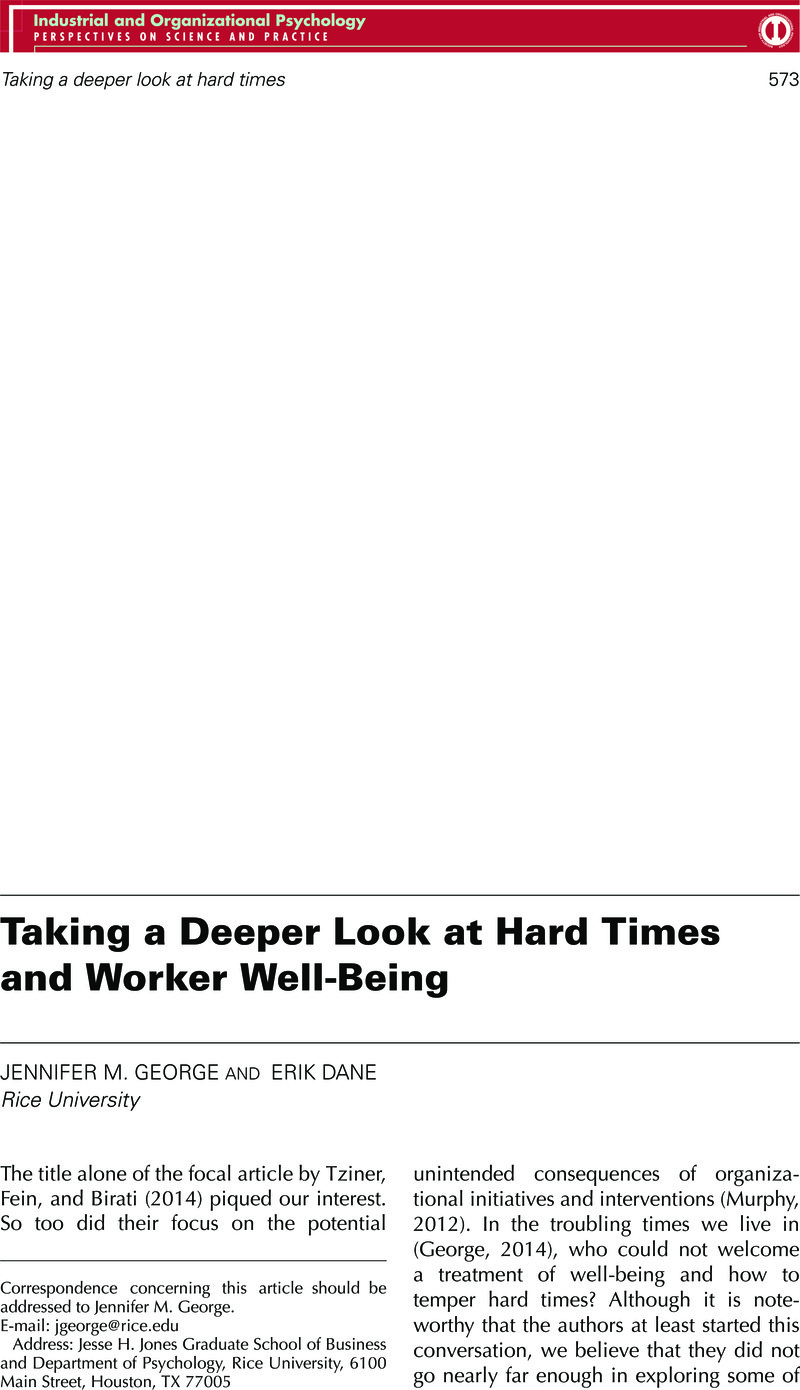No CrossRef data available.
Article contents
Taking a Deeper Look at Hard Times and Worker Well-Being
Published online by Cambridge University Press: 10 April 2015
Abstract
An abstract is not available for this content so a preview has been provided. Please use the Get access link above for information on how to access this content.

- Type
- Commentaries
- Information
- Copyright
- Copyright © Society for Industrial and Organizational Psychology 2014
References
Brief, A. P. (2000). Still servants of power. Journal of Management Inquiry, 9, 342–351.Google Scholar
Brief, A. P., & Atieh, J. M. (1987). Studying job stress: Are we making mountains out of molehills? Journal of Occupational Behaviour, 8, 115–126.Google Scholar
Bunderson, J. S., & Thompson, J. A. (2009). The call of the wild: Zookeepers, callings, and the double-edged sword of deeply meaningful work. Administrative Science Quarterly, 54, 32–57.Google Scholar
Centeno, M. A., & Cohen, J. N. (2010). Global capitalism: A sociological perspective. Malden, MA: Polity Press.Google Scholar
Economic Policy Institute. (2012). The state of working America: Inequality. Retrieved from http://stateofworkingamerica.org/inequality/Google Scholar
George, J. M. (2014). Compassion and capitalism: Implications for organizational studies. Journal of Management, 40, 5–15.Google Scholar
Jiliani, Z. (2011). How unequal are we: The top 5 facts you should know about the wealthiest one percent of Americans. ThinkProgress.org. Retrieved from http://thinkprogress.org/economy/2011/10/03/334156/top-five-wealthiest-one-percent/Google Scholar
Kalleberg, A. L. (2009). Precarious work, insecure workers: Employment relations in transition. American Sociological Review, 74, 1–22.Google Scholar
Kalleberg, A. L. (2011). Good jobs, bad jobs: The rise of polarized and precarious employment systems in the United States, 1970s to 2000s. New York, NY: Russell Sage Foundation.Google Scholar
McKee-Ryan, F. M., Song, Z., Wanberg, C. R., & Kinicki, A. J. (2005). Psychological and physical well-being during unemployment: A meta-analytic study. Journal of Applied Psychology, 90, 53–76.Google Scholar
Messick, D. M. (1999). Alternative logics for decision making in social settings. Journal of Economic Behavior & Organization, 39, 11–28.Google Scholar
Murphy, K. R. (2012). How the unintended consequences of organizational interventions complicate the assessment of economic utility. Economics and Business Letters, 1(4), 33–42.Google Scholar
Nord, W. R. (1977). Job satisfaction reconsidered. American Psychologist, 32, 1026–1035.Google Scholar
Perrow, C. (2000). An organizational analysis of organizational theory. Contemporary Sociology, 29, 469–476.Google Scholar
Reich, R. B. (2012). Beyond outrage: What has gone wrong with our economy and our democracy and how to fix it. New York, NY: Vintage Books.Google Scholar
Reuters. (2013). US poverty rises despite economic recovery, September 17, 2013. Reuters.com. Retrieved from http://www.reuters.com/assets/print?aid=USBRE98G0PN201330917Google Scholar
Roberts, S. (2013). Poverty rate is up in New York City, and income gap is wide, census data show. The New York Times, September 19. Retrieved from http://www.nytimes.com/2013/09/19/nyregion/poverty-rate-in-city-rises-to-21-2.html?_r&_r=0Google Scholar
Tziner, A., Fein, E. C., & Birati, A. (2014). Tempering hard times: Integrating well-being metrics into utility analysis. Industrial and Organizational Psychology: Perspectives on Science and Practice, 7(4), 554–568.Google Scholar
Uchitelle, L. (2006). The disposable American: Layoffs and their consequences. New York, NY: Alfred A. Knopf.Google Scholar
U.S. Census Bureau. (2013). About poverty—highlights, September 17, 2013. Social, Economic, and Housing Statistics Division: Poverty. Retrieved from https://www.census.gov/hhes/www/poverty/about/overview/Google Scholar
Walsh, J. P., Weber, K., & Margolis, J. D. (2003). Social issues and management: Our lost cause found. Journal of Management, 29, 859–881.CrossRefGoogle Scholar




